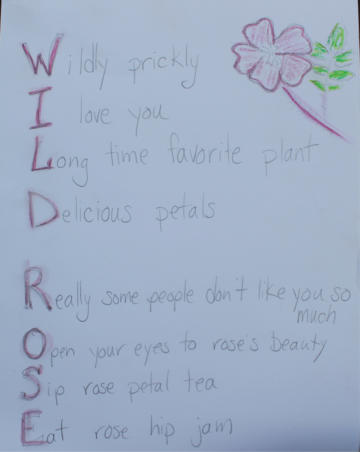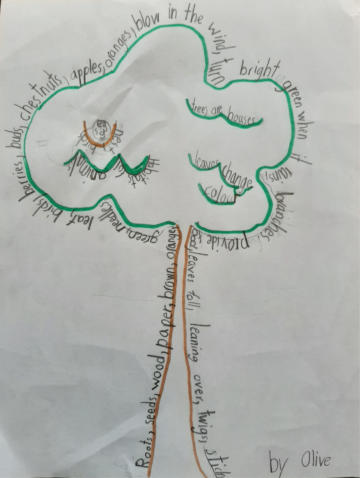Introduction:
Trees are a great source of inspiration for poetry because of their grace, majesty and importance to us. Below are three different types of poems to try.

Acrostic Poem:
An acrostic is a poem in which the first letter of each line spells out a word or words that describes the subject of the poem. You could use the word “tree” for your acrostic poem or a particular species.
1. Choose the subject of your poem – what would you like to write about?
2. Write this subject vertically (down) the left side of the page.
3. Brainstorm a list of words or thoughts about the subject you chose.
4. You can write a single word, a phrase or a sentence for each line – the only rule is that the first word for each line has to start with the “correct” letter. Maybe some words from your brainstorm can be used right away (their first letter is a letter in your subject). If so, fill them in.
5. Look at the spaces left, and fill them in to finish your poem.

Shape Poem:
Shape poems incorporate drawing and poetry, where the poem is written in such a way that the lines form a pattern, related to the subject of the poem. Our poem is about a tree. Adjust the instructions if you would like to write about something else – like a plant, a shrub or a leaf.
1. Brainstorm a list of words about trees. Think about all these things when you make your list:
• describing words for trees
• shapes of a trees
• the function of a tree
• the movements of a tree
• types of trees
• facts about trees
2. Draw an outline of your tree on a piece of paper. Try to fill the page with your drawing.
3. Begin to fill in your tree shape with your words.You can use sentences or groups of words to describe the tree or your feelings about the tree. Or simply write your words along the outline of the shape. If at first you don’t succeed, no problem – you can change the size of your tree shape or of your writing, or you can change how many words are in your poem.
4. Remember that the words should show the shape of your tree. You can erase the outline you drew or leave it there.If you want, you could add colour or small images to bring your shape poem to life.

Haiku:
Haiku is an ancient form of Japanese poetry. Usually, the theme is about nature or the seasons. Haiku poetry follows a certain recipe. Just like cookies, Haiku poems must have certain elements, or ingredients, in them to make them a Haiku. Typically, English Haiku consists of three lines which don’t necessarily have to rhyme:
1. The first line has 5 syllables,
2. The second has 7 syllables, and
3. The third has 5 syllables. A syllable is a single, unbroken sound of a spoken word.
Here is an example:
Toward those short trees
We saw a hawk descending
On a day in spring.
– Masaoka Shiki
Think about the subject – what you’d like to write about?
Think about what you’d like to say.
You could brainstorm a list of words related to your theme of trees or plants (or maybe you already have great description words from the acrostic or shape poems you’ve written).
Using your list of words, think of a good last line for your Haiku.
How would you like it to end?
What is the final thought or idea you’d like the reader to leave with?
Complete your Haiku by writing lines one and two. Remember to keep careful count of the syllables.










